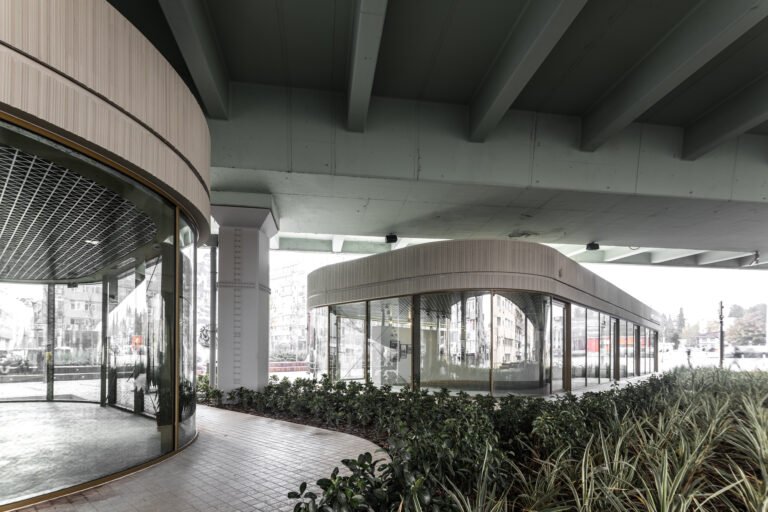Designs unveiled in “artistic ideas competition” for new National Museum of the United States Navy
Design teams led by five prominent architecture firms revealed proposals yesterday for what could lead to the next major museum in Washington, D.C.—a new home for the National Museum of the United States Navy.
The five teams were finalists in an “artistic ideas competition” held by the U. S Navy and its historical and curatorial arm, the Naval History and Heritage Command (NHHC), to show “the full spectrum of possibilities” for creating a museum and ceremonial courtyard that could replace the current 1962 museum that’s on the grounds of the Washington Navy Yard in the District of Columbia. The finalists included Bjarke Ingels Group (BIG), Gehry Partners, DLR Group, Perkins&Will, and Quinn Evans.
A location for the new museum has not been finalized but the Navy has a preferred site at M Street SE and 6th Street SE, just outside the security fence that surrounds the Navy Yard complex in southeast Washington. For the purposes of the ideas competition, the brief was “site-agnostic,” as one official put it.
The finalists were selected from 80 teams that expressed interest in participating after a Request for Qualifications was issued last December and 37 that submitted qualifications.
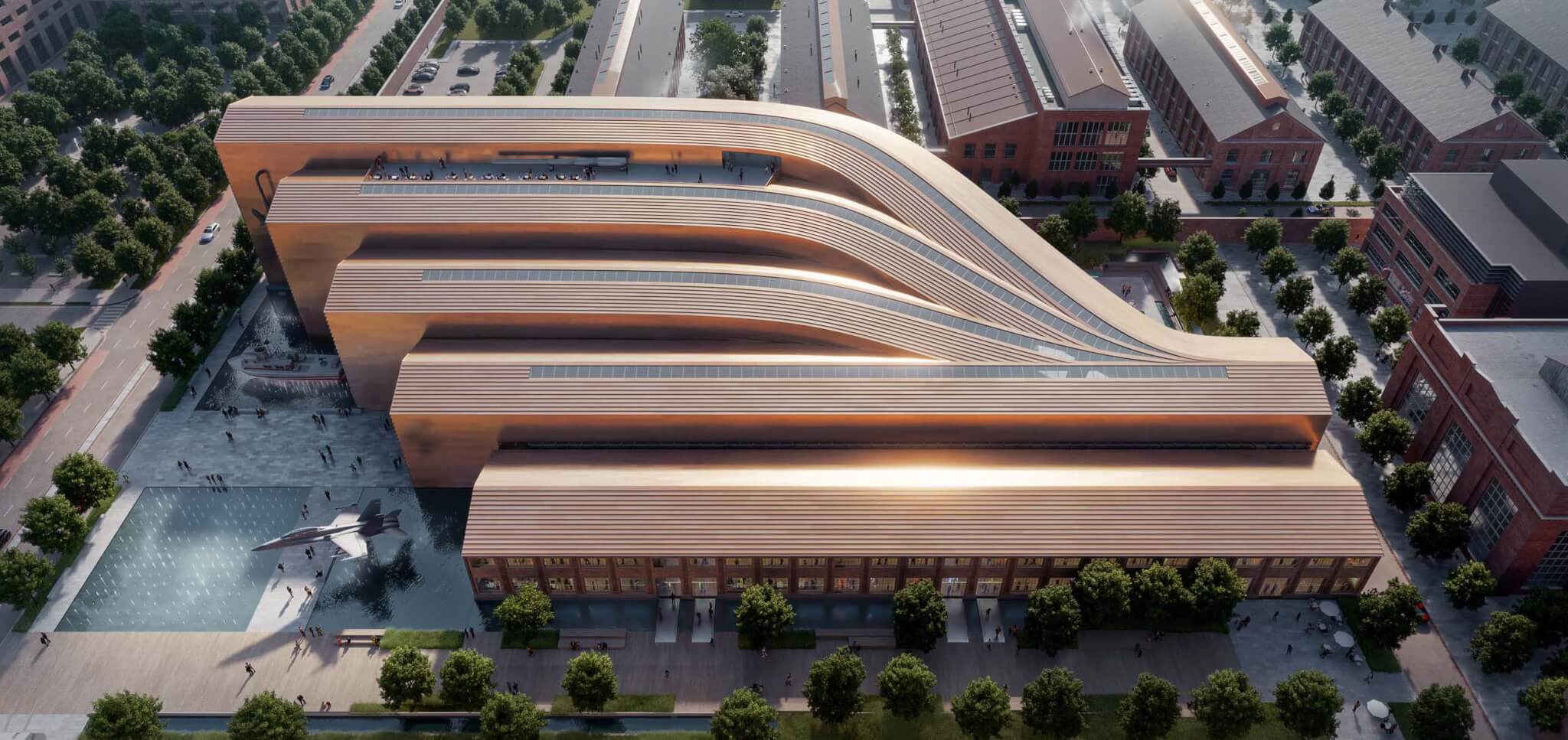
Exhibition and landscape consultants joined the architecture firms. DLR Group and Quinn Evans both named Gallagher & Associates as their exhibit designer. Perkins&Will named Local Projects as its exhibit designer. BIG had Olin, a landscape architect, and Squint/Opera, a digital media specialist, on its team. Gehry Partners consulted with Top Gun movie producer Jerry Bruckheimer.
As the Navy’s “institutional memory,” the NHHC is responsible for preserving, analyzing and disseminating U.S. naval history and heritage. It manages ten museums around the country that attract more than 1.5 million visitors a year, and it maintains a website that serves as a repository for Navy-related archives and other historical resources.
The NHHC’s vision is to create a new, “public-facing” museum and campus that will “energize public awareness of the integral role the Navy plays in the defense of our country and in the protection of our interests as a maritime nation.”
Besides honoring service members and veterans, the museum is intended to “engage, inspire and educate civilians, active-duty personnel and future generations of Sailors by connecting cutting-edge interactive and multimedia displays to the Navy’s most important and enduring historic artifacts.”
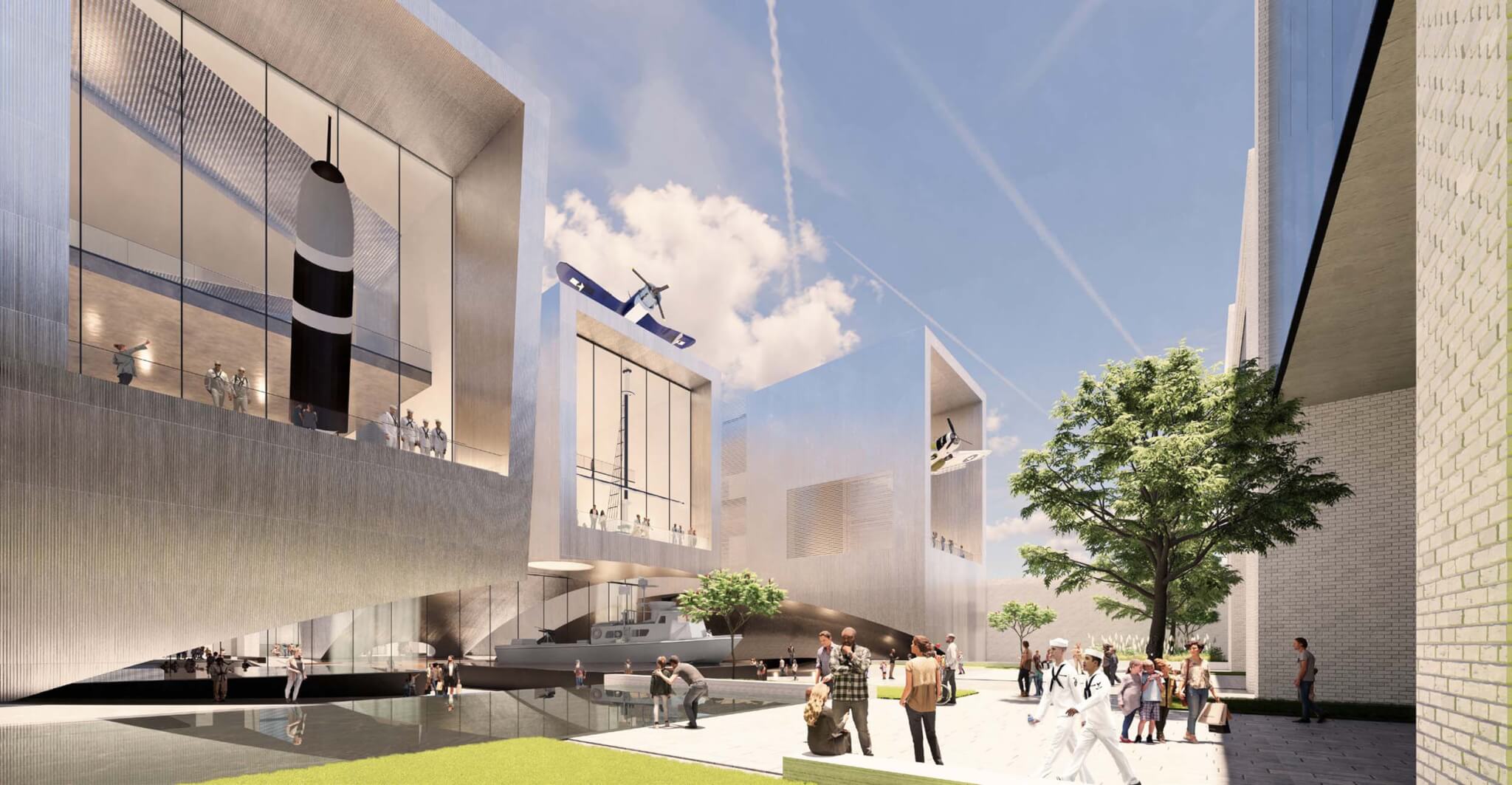
The goal of the competition, planners said, was to “share conceptual museum ideas with America” and find out what prospective visitors would like to see included in a new museum.
“The Artistic Ideas Competition is an effort to explore the full realm of artistic concepts that might be incorporated,” according to a fact sheet distributed at the event.
Each finalist received $50,000 for participating. A winner was not named. Organizers said all five submissions will be used to show the possibilities for creating a new museum in the nation’s capitol, and the renderings may be used to raise money to build it.
The organizers didn’t promise that any of the finalists would get the commission to design the new museum, and there is no expectation that any of the designs will be built as submitted. The RFQ stated, however, that the Navy and NHHC “will make evaluations and assessments on which conceptual artistic ideas may be considered for further conceptual development” and that the design concepts “may be used as a foundational basis for the future [museum] design.”
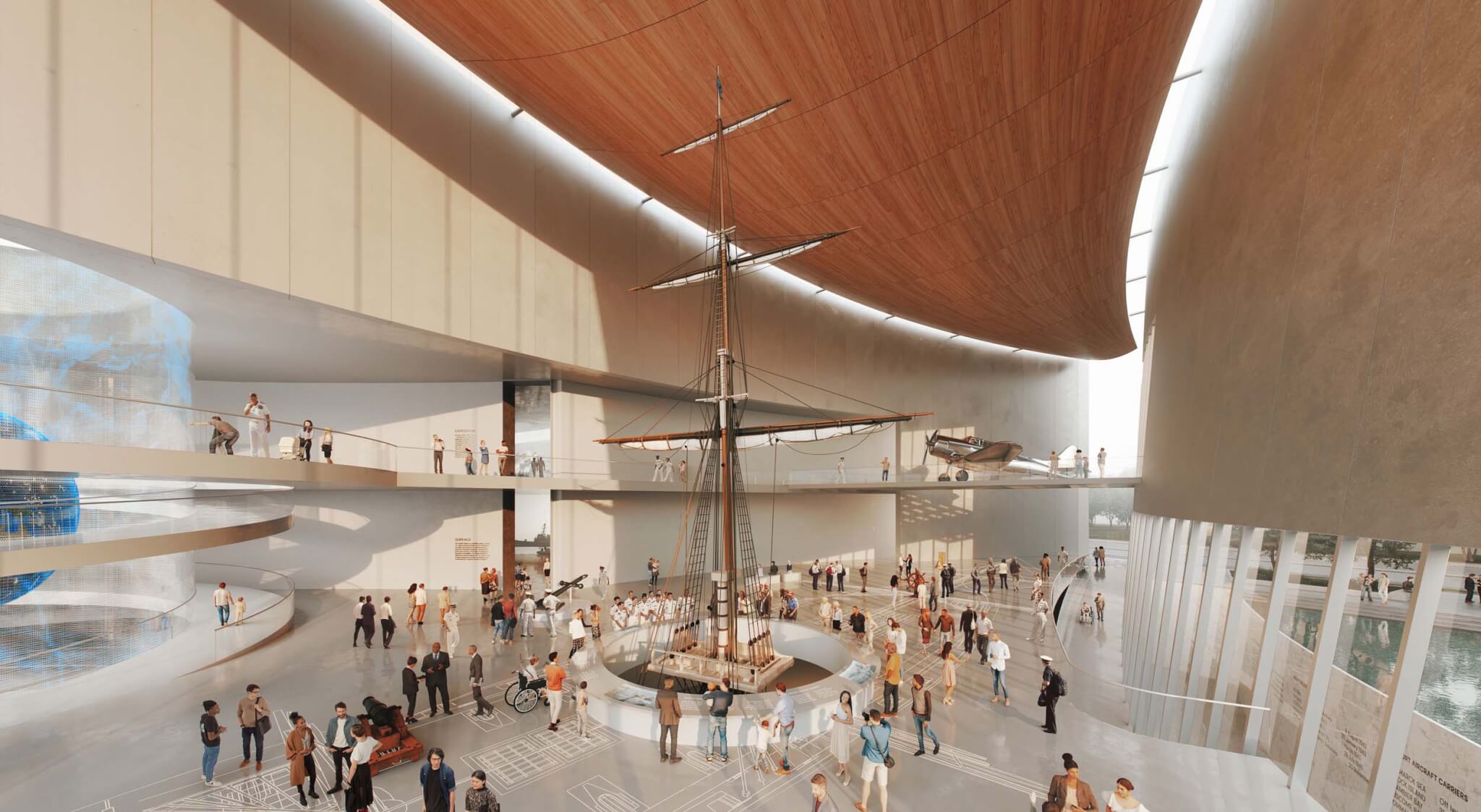
The two-month competition was managed for the Navy and the NHHC by Mark G. Anderson Consultants, design and construction project managers. The unveiling event was attended by high-ranking Navy officers including Secretary of the Navy Carlos Del Toro; leaders of the NHHC, and guests. It was the first time the designs were made public and the first time the finalists got to see what the other teams proposed.
“The concepts unveiled today are a crucial step in exploring what is possible for the new National Museum of the U.S. Navy,” said Samuel Cox, director of the NHHC. “We will tell the story of the Navy’s history as it continues to unfold, and the ideas developed by our finalists herald a new way of honoring that history by inviting visitors to participate.”
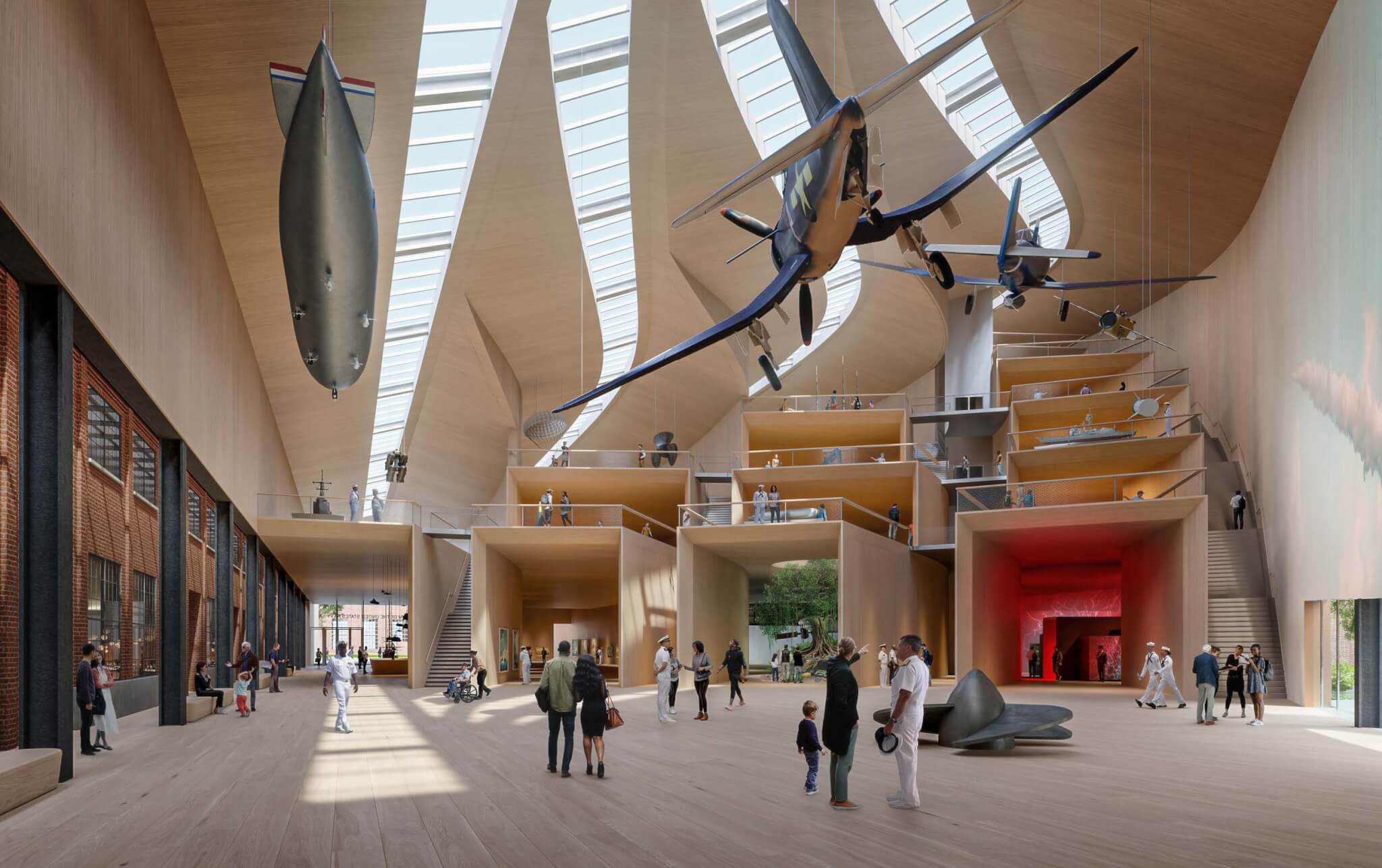
“We are excited to share these concepts with present and former service members, the arts and cultural communities, and the wider public as we explore potential approaches for the new museum,” added Charles Swift, acting director of the National Museum of the U. S. Navy. “Today’s finalists were chosen from a truly impressive and expansive group of national applicants. We are incredibly pleased with the singular visions each finalist has developed and are excited to share them with the world.”
David Ben-Israel, vice president of MGAC said, “We have been absolutely thrilled by the quality of submissions received from these five outstanding firms. It has been an honor to work with the NHHC team and the firms to take one more step towards a new national museum that pays tribute to the history and heritage of our nation’s Navy.”
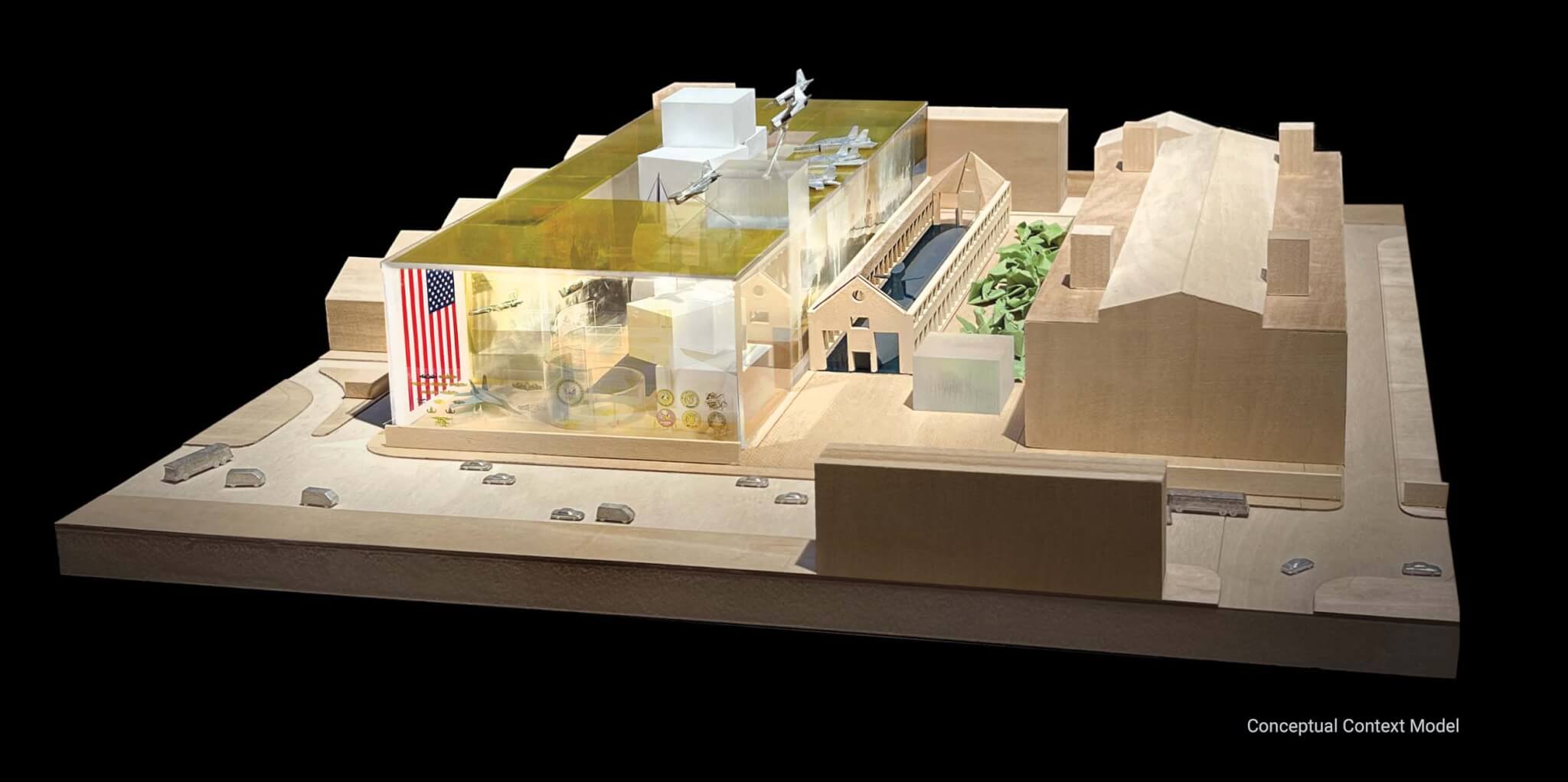
The finalists sent their own top designers to show their strong interest in the project and help explain their designs. Participants included Bjarke Ingels, founder and creative director of BIG; Alyson Steele, CEO of Quinn Evans; Brian O’Laughlin, senior associate from Gehry Partners; and principals from DLR Group and Perkins&Will.
Asked why Gehry, wanted to take part in the competition, O’Laughlin said Gehry is a veteran of the U. S. Army and appreciates the contributions all military service members make. “We thought this was a great project, really about showing who the Navy is,” he said. In addition to Gehry’s military background, O’Laughlin said, “He’s got a connection to this: He’s a sailor in his own right.” Gehry also has family members in the Navy.
Instead of joining forces with an exhibit design firm, O’Laughlin said Gehry consulted with Bruckheimer, the co-producer of Top Gun and Top Gun: Maverick, because he wanted to create a cinematic experience that would be to museums what Top Gun was to movies.
“Frank’s response was that he didn’t want to do what everybody else did,” O’Laughlin said, referring to other military museums. “He really wanted to think outside of the box, think a little bit bigger picture. So he called up Jerry Bruckheimer and said, ‘How do I make this building like Top Gun?’, because Top Gun does it so well in telling who the Navy is, and we want this building to do the same.” Frank’s respond was, “‘How do I make this building kind of like a movie where I can have these different experiences, these changing exhibitions, in a way that tells who the Navy is in a much grander way?’”
The project’s estimated budget is $475 million, according to the U. S. Naval Institute. Sponsors of the competition say their goal is for the museum to be privately funded. That makes it different from the museums planned by the Smithsonian Institution, which are owned by the federal government and rely on funding from the U. S. Congress.
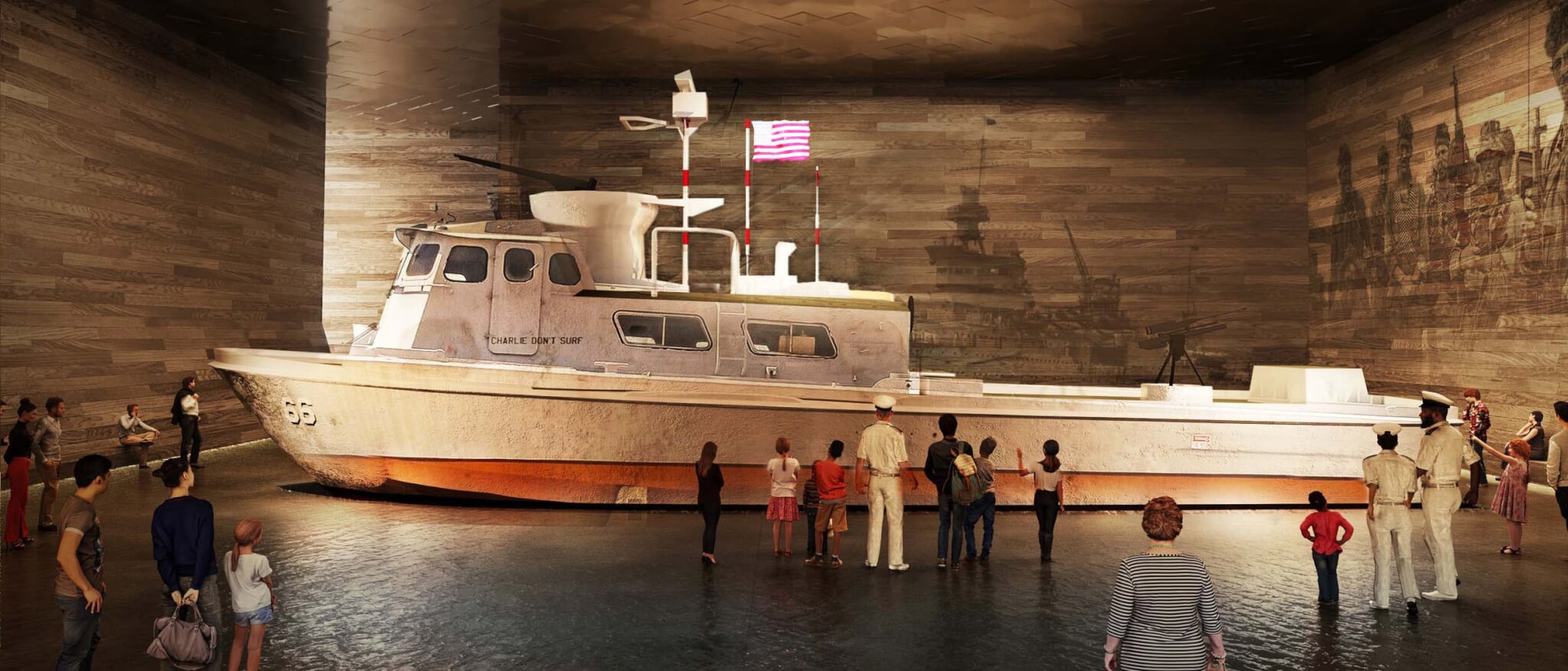
Moving the museum outside the fenced-in boundaries of the Navy Yard is seen as one way to increase attendance and exposure for the 61-year-old museum. At present, prospective visitors must pass through a security checkpoint to gain access to the Navy Yard complex, and the museum isn’t visible from outside the grounds—two factors that limit attendance. The current museum, in a building dating from 1889, gets about 100,000 visitors a year; the goal for the replacement museum is to attract one million visitors a year.
“The Navy envisions a future museum that would offer greater public access that could include a new building and the potential renovation of existing historical buildings,” according to a fact sheet prepared about the competition. “The planned museum campus would consist of approximately 270,000 square feet and include about 100,000 square feet of net gallery space.”
The finalists have been working on their submissions since January. They were allowed to display up to six boards, and they were given a series of topics to address, including the building’s form and massing, main entrance, atrium, gallery space and ceremonial courtyard. The organizers also wanted to see how the proposed buildings would incorporate some of the museum’s current “macro-artifacts” that they want to display, such as the top mast salvaged from the historic USS Constitution; a Corsair aircraft, a Swift boat and the sail of a submarine.
The finalists took a range of approaches.
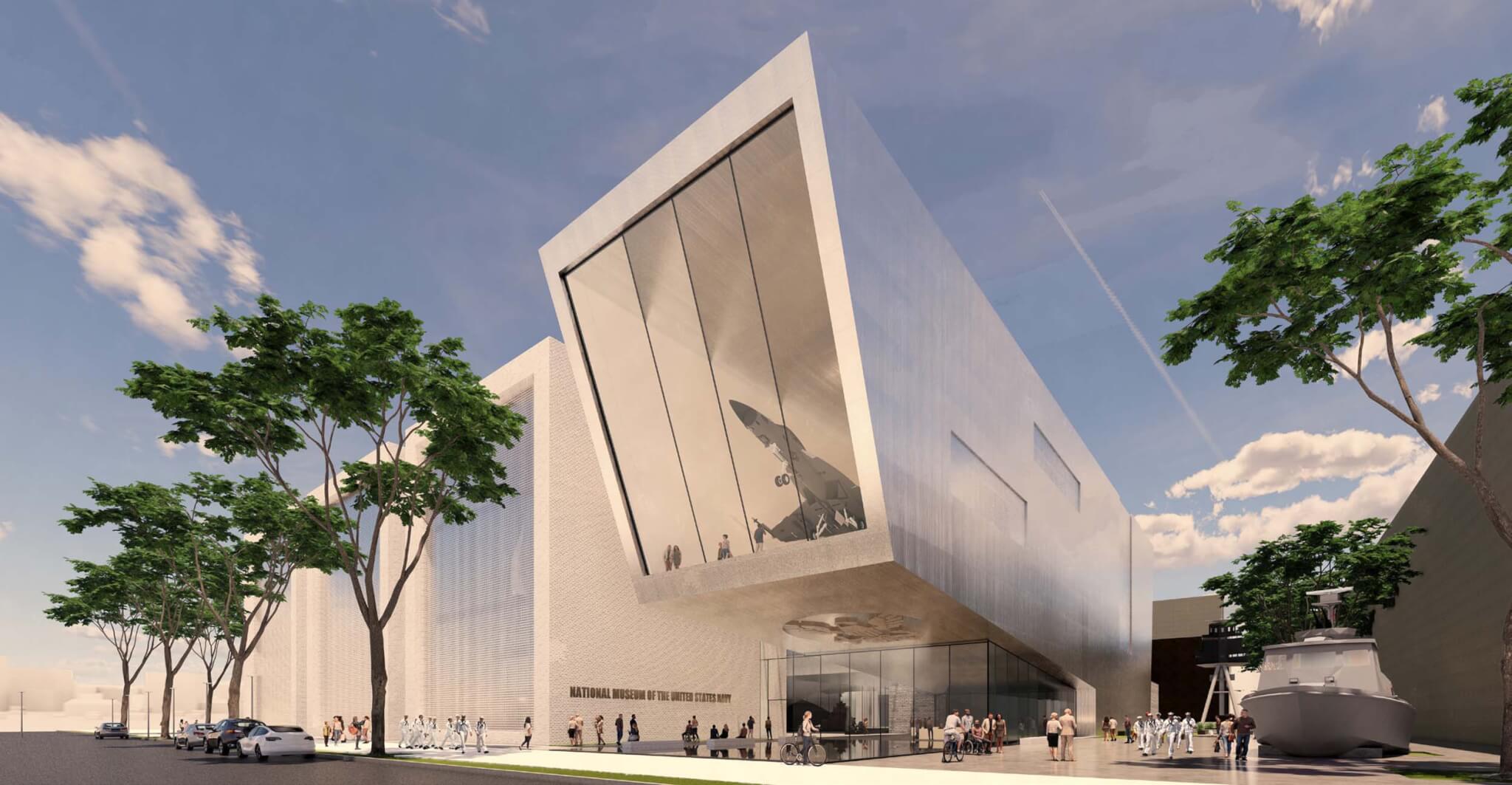
Quinn Evans conceived of the building as “Homeport,” a place where the land meets the sea and where “the community and the Navy come together.” The building’s long, linear forms “reflect the piers, ships and Navy Yard vernacular, providing a connection to the work of the Navy and a greater appreciation for its history and heritage.” With multistory window walls providing views of what’s inside, the museum “metaphorically places the individual visitor at the threshold of land and sea, surrounded by immersive experiences and paths of discovery.”
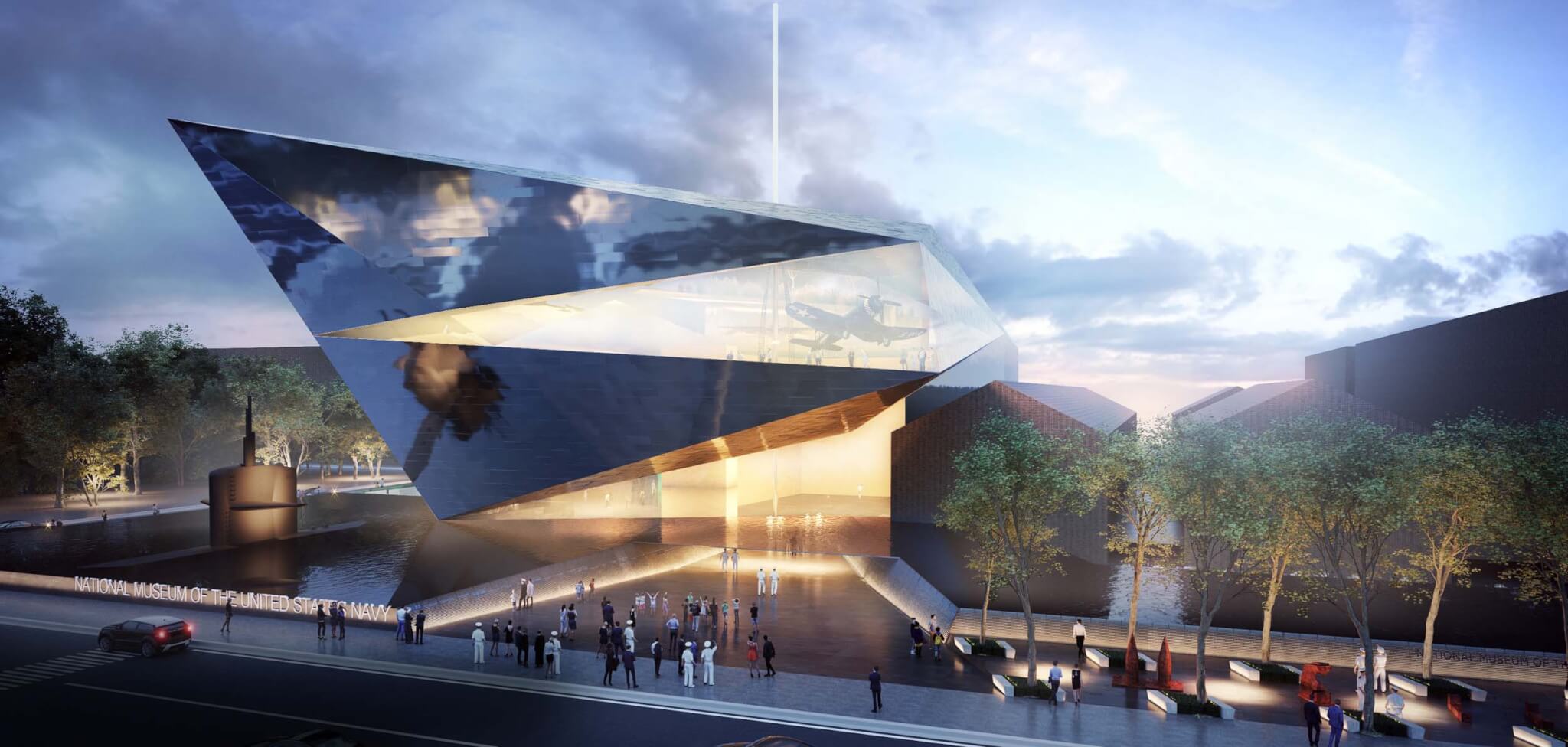
DLR Group designed a building whose faceted form is meant to be “a dialogue of water and sky,” said principal Dennis Bree. Visitors would enter “through water” and “rise to the sky” via an “interpretive platform lift,” then descend through ramped walkways toward the exhibit galleries, where they’ll learn about the Navy and its history. The building would be clad in reflective metal panels, so its shape reflects the water and the skies, “forging them together.” The preserved mast of the Constitution would be mounted on top of the occupiable portion of the museum, up to 170 feet in the air, making it a city landmark that’s visible from a great distance.
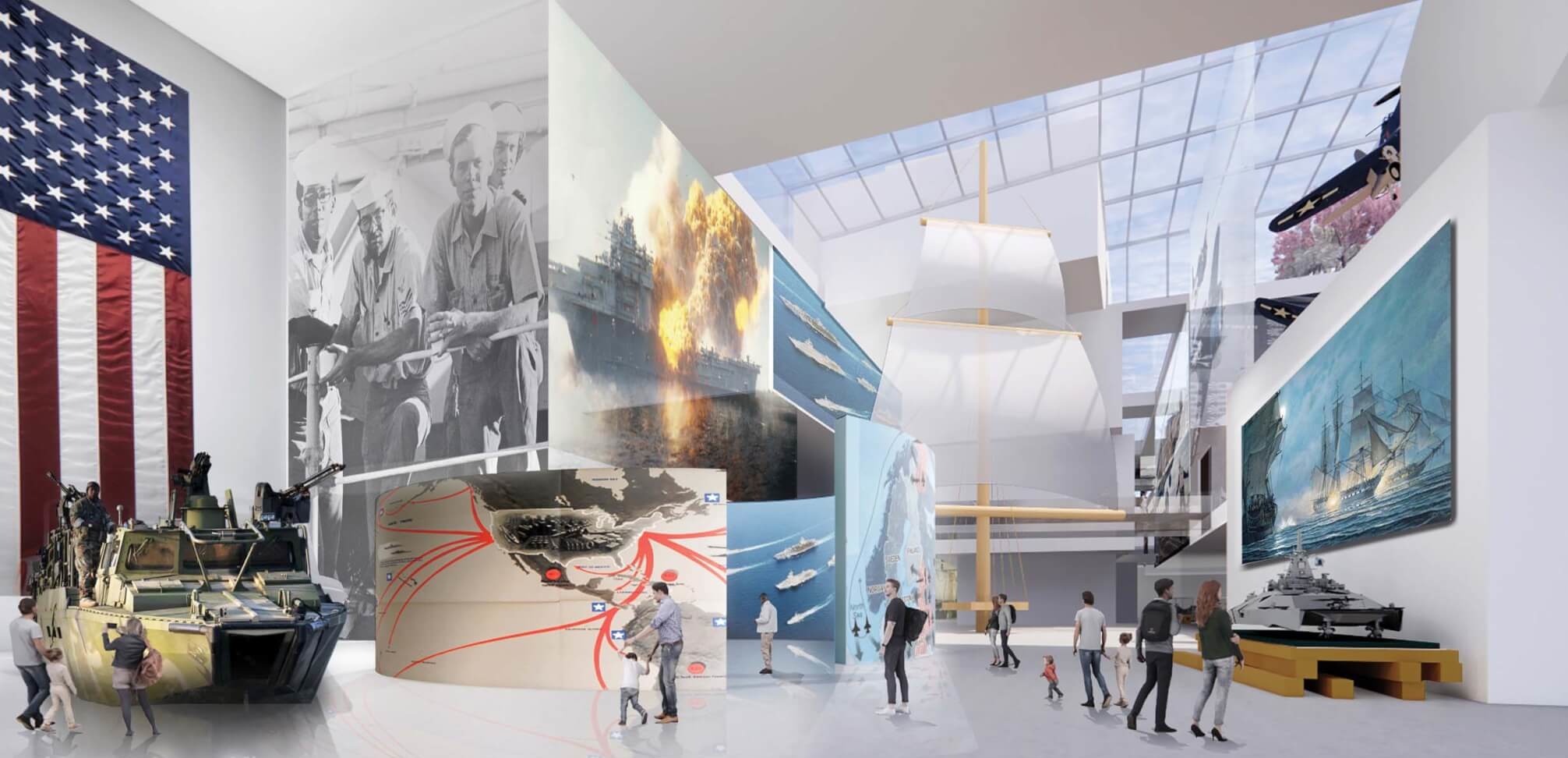
Gehry Partners, with Craig Webb as project designer, proposed a large simple volume with glass on three sides filled with naval artifacts and images that would be visible from outside the building. Inside, images, graphics and video projections would be layered to tell a story about the different eras in the Navy’s history. O’Laughlin said Gehry didn’t propose a highly sculptural form for the museum because he didn’t want the building’s form to overwhelm what the messaging is. “Frank didn’t want this big formal expression,” O’Laughlin said. “He didn’t want the building to take over. He really wanted to make a transparent building that allows the inside to tell the story. He wanted there to be transparency throughout the building.” The building is “meant to, on a subconscious level, not be so linear and to really convey the depth of who the Navy is.”
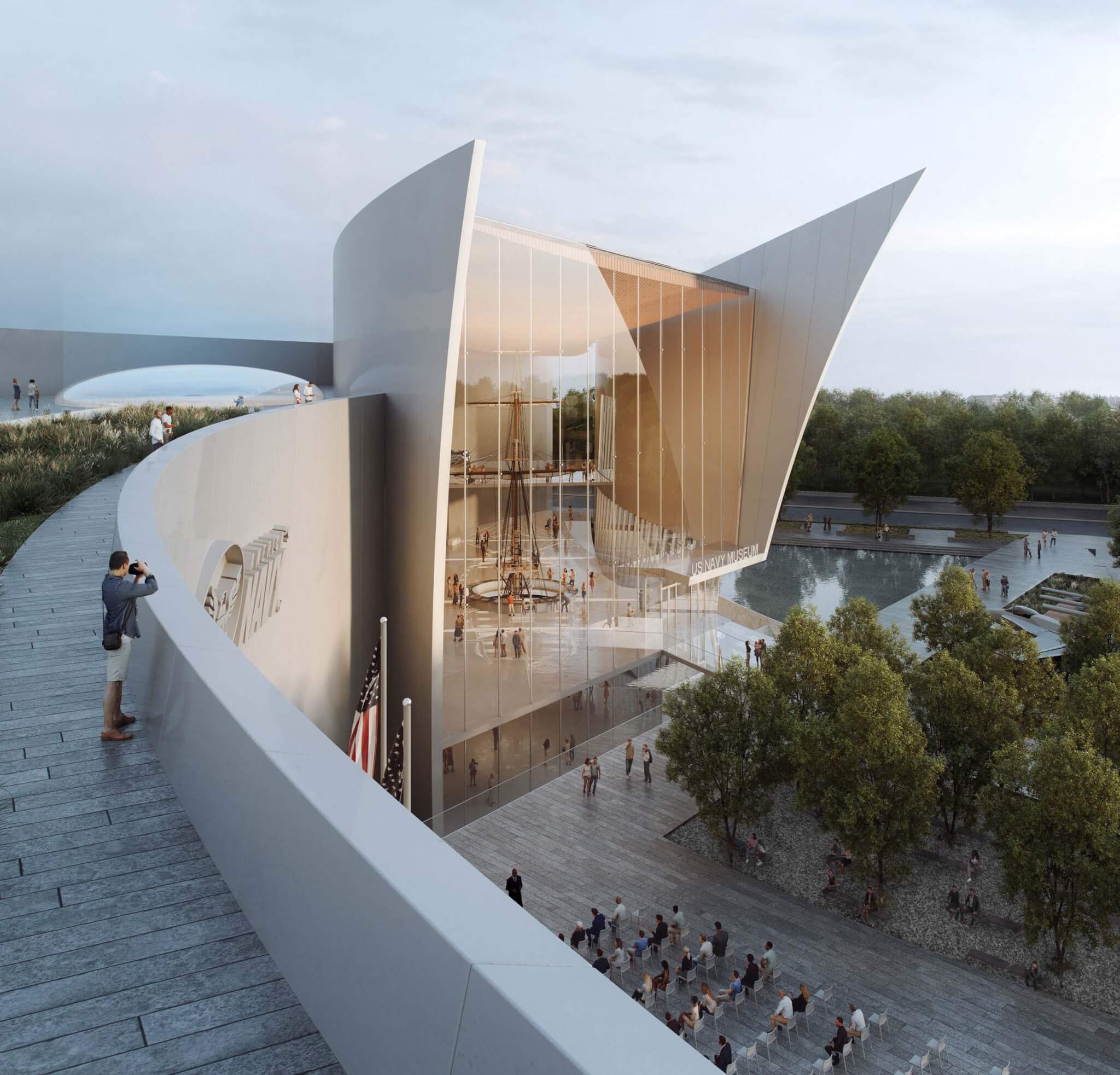
Perkins&Will conceived of the museum as “a physical manifestation of endurance,” symbolic of the “resilient and flexible fiber of the Navy—shaped and strengthened over centuries of maritime power.” Sail-like volumes sweep across the site, expressing a sense of balance between forces “Forged by the Sea.” The arrival experience marks “the moment a visitor leaves the civilian landscape to join the team-oriented world of the Navy” and explore its history “from the depths to the stars.” The Honor Courtyard is a place where land, air and sea intersect, and artifacts are displayed in settings that evoke the context in which they function.

BIG conceived of the museum as a series of five elongated, gabled galleries that increasingly step up in height and represent the five branches of the Navy: Surface, Subsurface, Exploration, Aviation, and Space. The five “wings” merge in a “sinuous plan,” creating a “landmark” atrium space on the inside and a sculptural roofscape on the outside. The designers say the stepping-up of the volumes is a reference to “the formation of naval fleets in the ocean and the sky,” while the gables are references to the gabled buildings elsewhere in the Navy Yard and their copper cladding is inspired by the overlapping wood boards or metal plates on a ship’s hull. The wings could be built in two or more phases, as funding permits.
Renderings from the competition will remain on display at the current Navy Yard museum during its operating hours. Select renderings are also viewable online.
Now that the designs have been unveiled, the competition organizers intend to get reaction from the public to see what resonates with potential visitors. The first focus group will be in two weeks. Those wishing to comment on the designs can visit the Naval History and Heritage Command Facebook page or send an email to NHHC_NMUSNMuseumNews@us.navy.mil. The NHHC plans additional public showcases this summer.
Swift, the museum’s acting director, said the Navy and NHHC hope to arrive at a design and secure funds in time to break ground on October 13, 2025, the Navy’s 250th anniversary. Once the new museum opens, the existing building will be used by the NHHC for “back of the house” purposes such as collections storage, he said.
Edward Gunts is a freelance writer and the former architecture critic for The Baltimore Sun.


